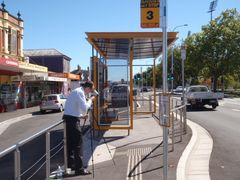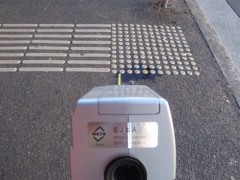Luminance Contrast Testing
Luminance contrast testing will assist to ensure that your building complies with disabled access requirements for visually impaired people. A large proportion of people who are visually impaired are still able to distinguish variations in shade of colour. Section 23 and 24 of the Disability Discrimination Act seeks to ensure that people with a disability have equal access to premises, good, services and facilities. The Building Code of Australia (BCA) calls up the Australian Standards for access and mobility, AS 1428.1 which requires that surfaces required to comply with disabled access, have sufficient luminance contrast such as stair nosings to clearly delineate the step edge.
Sufficient luminance contrast of surfaces can visually warn people of impending hazards such as kerb ramps, stairs, bus stops and railway station platform edges. Luminance contrast is required as per AS1428.4 Tactile Indicators. The degree of luminance contrast for Tactile Ground Surface Indicators (TGSI’s) is dependent on whether the Tactile Ground Surface Indicator (TGSI) is an integrated TGSI, discrete TGSI or composite TGSI.
So what is luminance contrast? Luminance contrast tests the difference in how black or white a colour is (luminance reflectance) of adjacent colours using a colour meter. A formula is then used to determine the contrast using the 2 luminance reflectance values. Luminance reflectance measures the black white scale of colour, or how grey a colour is, not directly colour. A luminance test result of 100 is considered to be pure white and a luminance test result of 0 is considered to be pure black. Care must be taken when comparing results of luminance reflectance testing, as the test results of generic materials or colours cannot be determined unless tested.
Luminance contrast testing must be conducted in wet and dry conditions for all external surfaces and those that are likely to be wet during normal usage. The luminance reflectance test results of water absorbing materials generally reduce when wet (appears darker); this can change the luminance contrast test results significantly.
The results of luminance contrast testing can also change if surfaces are not cleaned properly, due soiling material making the surface look dirty and appear darker. Sealers may also make surfaces look darker and some surfaces may also change colour due to UV degradation.
Safe Environments provide luminance contrast testing in Sydney, Melbourne, Brisbane, Canberra, Perth, Adelaide, Hobart and Darwin using instruments calibrated by NATA accredited laboratories to ensure accuracy and reliability of results. Our consultants have a broad range of expertise in materials science, building surveying, disability access, ergonomics and occupational hygiene.




